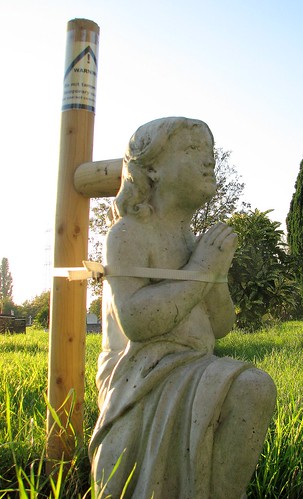Finally someone's standing up to the topple tyranny; John Mann, a Labour MP for Bassetlaw.
John Mann says no-one has been killed by falling headstones in churchyards in the past 10 years. Yet families are being forced to pay for graves to be made safe in local council graveyards because of "inaccurate" risk assessment tests. Headstones are made safe by a process known as "staking", in which wooden stakes are driven into the ground next to the headstones to prevent them toppling over.
The Local Government Association states that most councils pay to make graves safe themselves, but where grave owners are charged to make graves safe the costs are reasonable. I'm not sure what reasonable is, but our local cemetery manager told us the cost and it was somewhere around £200 or £300 ($400-$600).
I'd say that roughly between 70% to 80% of graves in our local cemetery have been staked.

And as Mann points out, these aren't necessarily the old graves, but rather ones less than a decade old. He paid for a topple test and claims that 95% of the staking is unnecessary.
These things simply don't fall on people. There is much more chance of people dying on their way to church," added Mr Mann.
New health and safety guidelines for gravestones were issued in 2004 after reports of five deaths caused by falling headstones. But Mr Mann said councils were being "tremendously over zealous" in their application of the rules and "a whole industry" had sprung up around "topple-testing" of graves. He said the graves being tested were often too small to topple over and cause injury let alone death - but they were still being "staked" by private contractors, at a cost of "hundreds of pounds" to berieved families.
Oh yes. We had a run-in with one of these contractors back in March.
The ViL pointed to the staked marker at our feet. The plastic straps weren't even touching the headstone, which was one of those low lying ones that barely rose 12 inches from the ground. Sure it was at risk of crumbling - if you jumped on it, a bunch - but the stake rising from the ground at a 45 degree angle posed a greater safety hazard.
In a radio interview yesterday, Mr Mann also claimed that the stakes themselves were a greater risk to health and safety, being trip hazards. I'd concur. I've seen headstones that stood no more than ten inches off the ground staked - with the stake standing dangerously high over the marker.

a martyr to health and safety
Mr Mann further states that trees and branches are a bigger hazard to the cemetery visitor. Certainly in our local cemetery many branches hang hazardously from old and cankered trees and the footpaths are dangerously uneven - an elderly person might easily fall and break a hip.
Really. This staking is just plain insane, especially when one can spot greater risks with an untrained eye. And how this fits in with the policy recommendation to make better use of these dead spaces is beyond me.
1 comment:
And tell me, when is the last time you saw a school zone, with a lowered speed limit? Or for that matter a proper school bus with stop signs sticking out the side?
Post a Comment